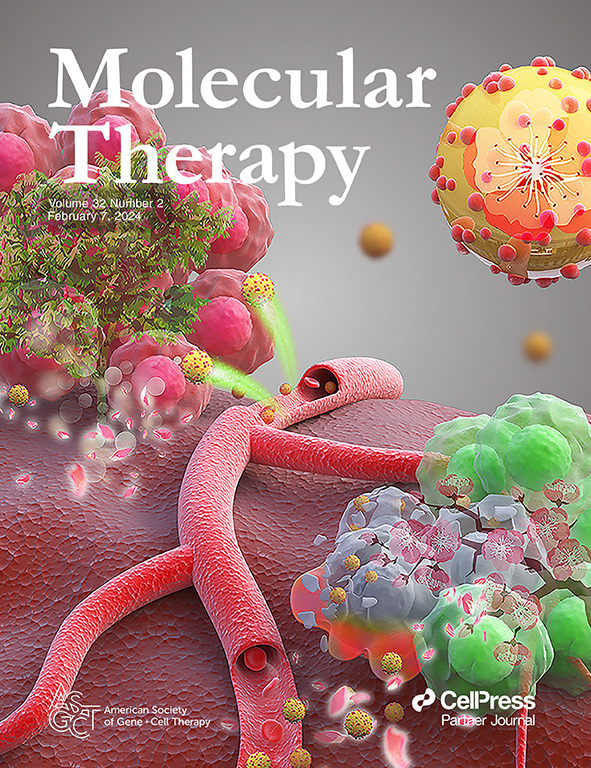The conserved N-terminal histidine in an engineered peptide mediates sepsis treatment efficacy via dual binding to CD14 and LPS.
IF 12
1区 医学
Q1 BIOTECHNOLOGY & APPLIED MICROBIOLOGY
引用次数: 0
Abstract
Sepsis remains a major clinical challenge due to the limited efficacy of existing therapies in controlling excessive inflammation. The engineered stapled peptide sHVF18, derived from an evolutionarily conserved thrombin innate fold, binds both lipopolysaccharide (LPS) and the LPS-binding groove of CD14, enabling dual targeting of bacterial components and host immune signaling. To define structural prerequisites for this dual action, we combined evolutionary analysis, in silico modeling, and experimental methods. Substituting the N-terminal histidine with lysine (K) or arginine (R) improved solubility, reduced aggregation, and enhanced interactions with LPS. However, unexpectedly, K-substitutions impaired CD14 binding, whereas R variants retained weaker affinity, possibly through cation-π interactions. The essential role of the evolutionarily conserved N-terminal histidine for CD14 interactions and therapeutic efficacy was demonstrated using LPS-induced shock and polymicrobial sepsis models. While the K variant exhibited superior efficacy in LPS-induced shock, its disrupted CD14 interactions rendered it ineffective in polymicrobial sepsis. In contrast, sHVF18, by engaging both LPS and CD14, effectively reduced inflammation and improved survival in polymicrobial sepsis. These findings highlight that targeting of both LPS and CD14 is essential for therapeutic efficacy, underscoring multivalency as a key principle for future sHVF18-based sepsis therapeutics.工程肽中保守的n端组氨酸通过与CD14和LPS的双重结合介导脓毒症的治疗效果。
脓毒症仍然是一个主要的临床挑战,因为现有的治疗方法在控制过度炎症方面的疗效有限。从进化上保守的凝血酶固有折叠中衍生的工程钉接肽sHVF18可结合脂多糖(LPS)和CD14的脂多糖结合槽,从而实现细菌成分和宿主免疫信号的双重靶向。为了定义这种双重作用的结构先决条件,我们结合了进化分析、计算机建模和实验方法。用赖氨酸(K)或精氨酸(R)取代n端组氨酸改善了溶解度,减少了聚集,增强了与LPS的相互作用。然而,出乎意料的是,k取代破坏了CD14的结合,而R变体保留了较弱的亲和力,可能是通过阳离子-π相互作用。通过lps诱导的休克和多微生物脓毒症模型证明了进化上保守的n端组氨酸在CD14相互作用和治疗效果中的重要作用。虽然K变异体在lps诱导的休克中表现出优越的疗效,但其破坏的CD14相互作用使其在多微生物脓毒症中无效。相比之下,sHVF18通过结合LPS和CD14有效地减少炎症并提高多微生物脓毒症的生存率。这些发现强调了LPS和CD14的靶向性对治疗效果至关重要,强调了多效性是未来基于shvf18的败血症治疗的关键原则。
本文章由计算机程序翻译,如有差异,请以英文原文为准。
求助全文
约1分钟内获得全文
求助全文
来源期刊

Molecular Therapy
医学-生物工程与应用微生物
CiteScore
19.20
自引率
3.20%
发文量
357
审稿时长
3 months
期刊介绍:
Molecular Therapy is the leading journal for research in gene transfer, vector development, stem cell manipulation, and therapeutic interventions. It covers a broad spectrum of topics including genetic and acquired disease correction, vaccine development, pre-clinical validation, safety/efficacy studies, and clinical trials. With a focus on advancing genetics, medicine, and biotechnology, Molecular Therapy publishes peer-reviewed research, reviews, and commentaries to showcase the latest advancements in the field. With an impressive impact factor of 12.4 in 2022, it continues to attract top-tier contributions.
 求助内容:
求助内容: 应助结果提醒方式:
应助结果提醒方式:


